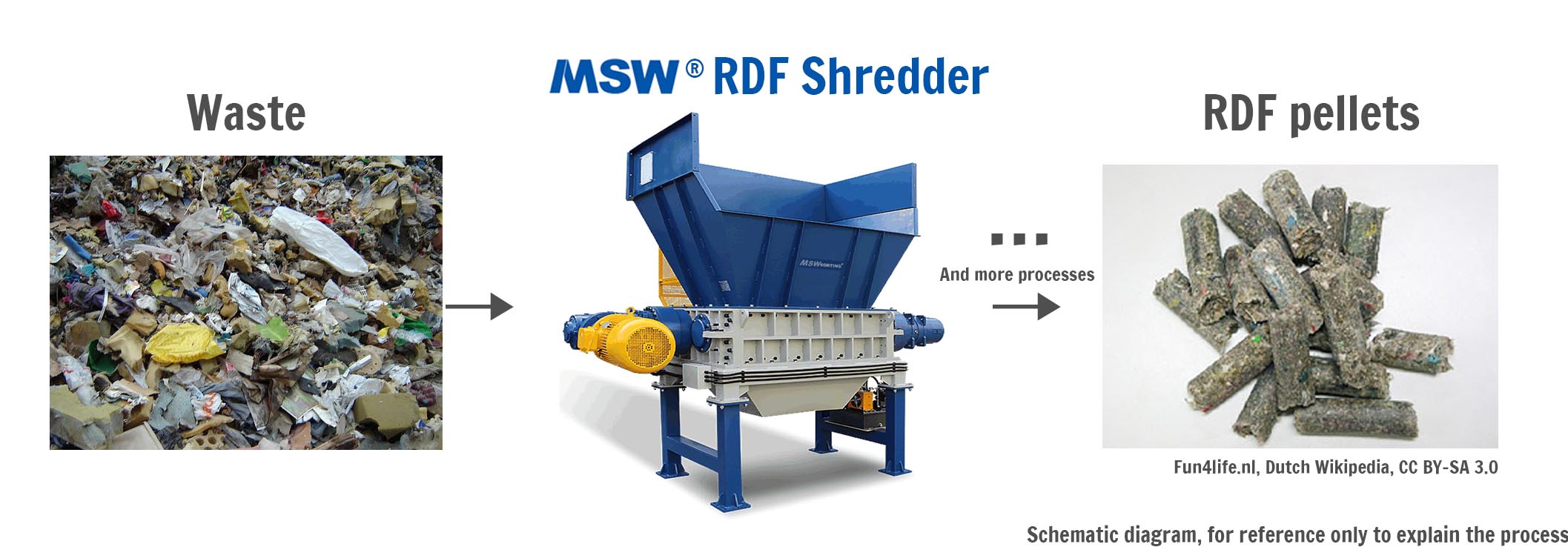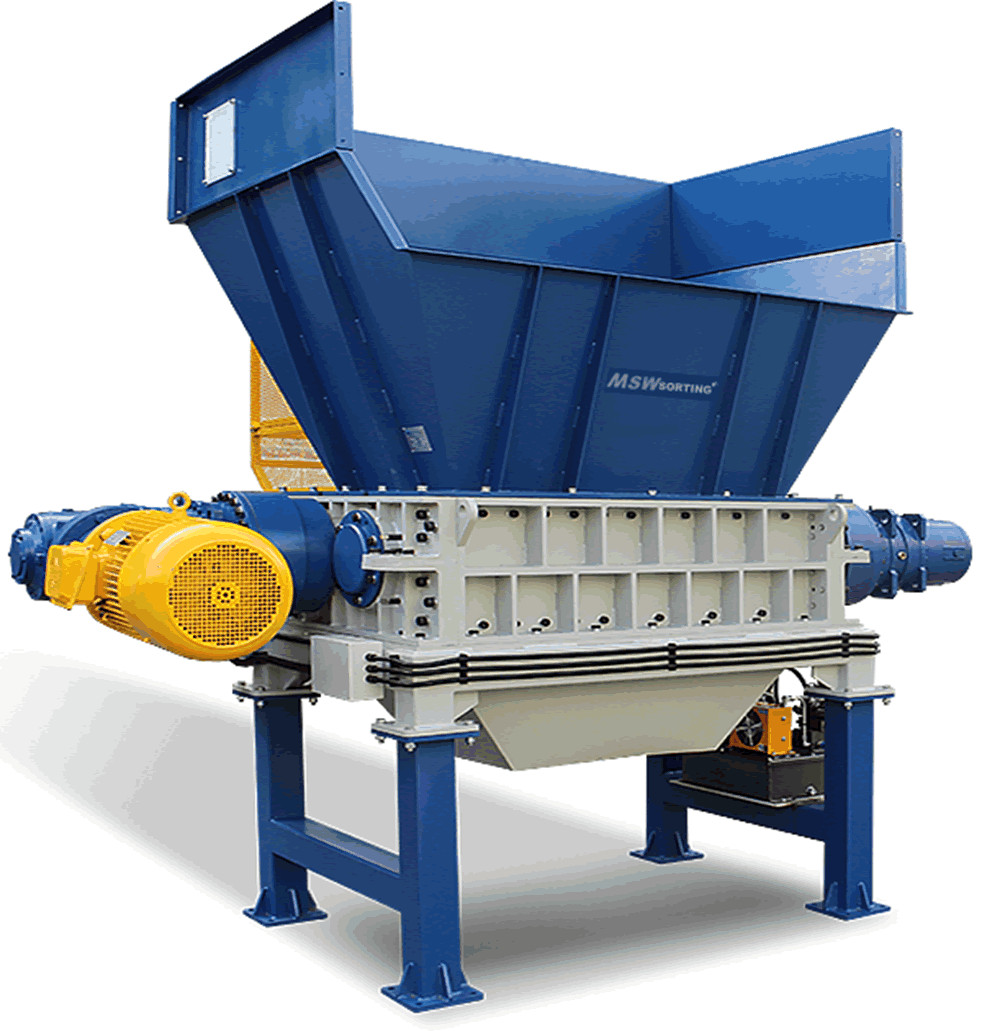
Refuse-Derived Fuel (RDF) shredder are revolutionizing waste management by converting municipal solid waste into high-calorific fuel alternatives. Unlike traditional landfilling or incineration, RDF processing achieves dual environmental benefits - it boosts the energy content of waste materials by 20-30% while dramatically reducing toxic emissions like dioxins that plague conventional waste-to-energy plants.
The shredding process plays a crucial role in RDF production by homogenizing waste streams and removing incombustibles. Modern RDF shredders with advanced separation technologies can achieve consistent 14-18 MJ/kg calorific values, making the output suitable for co-processing in cement kilns and specialized power plants. This represents a significant improvement over raw waste incineration, where inconsistent composition often leads to incomplete combustion and higher pollutant emissions. RDF shredder is helpful for solid waste size reduction.
European Union's Waste Framework Directive (WFD) has become a global benchmark for progressive waste policies, mandating 65% municipal waste recycling by 2035 and effectively banning untreated waste landfilling. Similar "zero landfill" initiatives are emerging worldwide, from South Korea's mandatory volume-based waste fee system to California's SB 1383 regulations targeting 75% organic waste diversion.
These policies are driving standardization in RDF specifications, with the European standard EN 15359 establishing quality classes based on calorific value, chlorine content and mercury levels. Shredder manufacturers have responded by developing equipment capable of producing SRF (Solid Recovered Fuel) that meets the strictest R1 energy recovery efficiency criteria. The latest systems incorporate real-time composition monitoring using XRF technology to ensure consistent output quality demanded by energy-intensive industries adopting RDF as alternative fuel.
Technical Breakdown of RDF Production Process
The transformation of raw municipal waste into high-quality Refuse-Derived Fuel requires precisely engineered systems that address the complex nature of mixed waste streams. Modern RDF facilities operate as sophisticated material recovery plants where each processing stage builds upon the previous one to create a consistent, energy-dense fuel product meeting industrial specifications.

Pre-treatment System Optimization
Effective RDF production begins with comprehensive waste characterization studies that analyze seasonal variations in composition and calorific value. Moisture control becomes critical at this stage, as excessive water content below 15% dramatically reduces combustion efficiency. Many facilities now employ mechanical drying tunnels that use waste heat from downstream processes to pre-dry materials before shredding, creating an energy-efficient closed-loop system.
Advanced separation technologies form the backbone of modern pre-treatment lines. Overband magnets remove ferrous metals with 99% efficiency while eddy current separators recover non-ferrous metals through induced electromagnetic fields. The latest optical sorting systems using hyperspectral imaging can identify and remove glass contaminants down to 3mm fragments that traditional screens might miss. These systems work in tandem to ensure the shredded material meets the stringent<1% inert content requirement for premium RDF grades.
Innovations in Core Shredding Technology
The heart of RDF production lies in its multi-stage size reduction system. For challenging elastic materials like textiles and rubber, slow-speed high-torque shear shredders operating at 15-30 RPM deliver consistent tearing action without wrapping issues. These machines feature specially designed staggered hook-shaped cutters that grab and pull materials into the cutting zone, processing entire mattresses or carpets in single passes.
Brittle components require different treatment, where impact crushers with hardened manganese steel hammers efficiently shatter glass and ceramics into safer, non-sharp fragments. The final homogenization stage typically employs high-speed fine shredders to achieve the ideal 10-50mm particle size range that optimizes combustion in cement kilns. This carefully calibrated size distribution ensures complete burnout while maintaining sufficient porosity for optimal airflow in industrial burners.
Industrial Applications and Carbon Reduction Benefits of RDF Fuel
Refuse-Derived Fuel has emerged as a game-changing alternative energy source for industries requiring high-temperature processes. Its adoption represents a circular economy success story, where waste materials displace fossil fuels while meeting stringent environmental standards. The technical and environmental performance of RDF has been proven across multiple energy-intensive sectors, demonstrating measurable reductions in both operational costs and carbon footprints.
Alternative Fuel for Energy-Intensive Industries
Cement manufacturers have become leading adopters of RDF, with modern kilns capable of substituting 30% of coal consumption while maintaining clinker quality. The thermal compensation calculation reveals that 1 ton of premium RDF at 4,500 kcal/kg can replace approximately 0.6 tons of standard coal, with the added benefit of lower sulfur emissions. Advanced precalciner systems allow precise temperature control when using RDF, ensuring complete combustion at the required 1,450°C clinkering temperature without compromising product quality.
Waste-to-Energy plants have developed sophisticated co-combustion techniques to integrate RDF into their operations. Modern facilities employ stepped-grate incinerators with separate RDF feeding systems that maintain optimal burning conditions. These plants combine selective non-catalytic reduction (SNCR) with activated carbon injection and baghouse filters to meet emission standards even with varying RDF compositions. The latest flue gas treatment upgrades can achieve dioxin levels below 0.1 ng TEQ/Nm³, outperforming many conventional coal-fired power plants.
Life Cycle Assessment Findings
Comprehensive Life Cycle Assessments demonstrate RDF's environmental superiority over traditional waste disposal methods. When comparing complete systems from waste collection to final disposal, RDF utilization shows 60% lower greenhouse gas emissions measured in CO2 equivalents compared to landfilling. This accounts for avoided methane emissions from landfills combined with displaced fossil fuel consumption in industrial applications. The carbon benefit becomes particularly significant when considering the 21-28 times greater global warming potential of methane compared to CO2 over a 100-year timeframe.
Scientific studies on heavy metal behavior confirm effective immobilization in RDF combustion residues. Cement kiln testing shows over 95% of lead, cadmium and zinc become chemically bonded in the clinker matrix, with leaching tests consistently below regulatory thresholds. The high pH environment in cement manufacturing (pH>11) promotes the formation of stable metal hydroxides and silicates. Long-term monitoring of RDF-derived fly ash in landfills demonstrates negligible heavy metal mobility, with diffusion coefficients orders of magnitude lower than in untreated municipal waste ash.
Investment Decision Guide for RDF Shredder Projects
Establishing an efficient RDF production line requires careful evaluation of both technical parameters and market dynamics. Savvy investors must consider not just the capital expenditure for shredding equipment, but the entire ecosystem that determines long-term profitability. Modern RDF operations balance processing efficiency with product quality to meet industrial clients' exacting fuel specifications.
Equipment Selection and ROI Modeling
The choice between different shredder types involves fundamental trade-offs between throughput capacity and operational costs. High-volume operations processing 300+ tons per day typically opt for manganese steel cutters that offer better impact resistance when encountering unexpected metal contaminants, though requiring replacement every 800-1,200 operating hours. Hardened alloy cutters extend service life to 2,000+ hours but demand more stringent pre-sorting to avoid chipping damage, making them ideal for facilities with advanced material recovery systems.
Financial models now increasingly incorporate government incentives that significantly improve project economics. Carbon trading schemes in progressive markets can generate €15-25 per ton of CO2 equivalent saved through fossil fuel displacement. When combined with renewable energy certificates and waste processing subsidies, these green incentives can reduce payback periods from 5 years to as little as 2.5 years for mid-sized RDF plants. Investors should work closely with environmental accountants to fully capture these fiscal benefits in their projections.
Critical Risk Management Considerations
Seasonal variations in waste composition present one of the most persistent challenges for RDF operations. Monsoon seasons in tropical regions can spike moisture content beyond 40%, requiring shredders to handle slippery, compressible materials that reduce throughput by 30-50%. Smart operators install torque monitoring systems that automatically adjust feed rates when processing such difficult loads, preventing motor overloads while maintaining steady production. Some advanced facilities now incorporate real-time moisture sensors that trigger pre-drying cycles when detecting wet material streams.
The RDF market exhibits regional price volatility tied to cement industry demand cycles. Southeast Asian markets have seen spot prices fluctuate between $80-150 per metric ton, with premium prices paid for consistent 15-25mm particle sizes and<1% inert content. Forward-thinking operators establish long-term offtake agreements with cement producers, often linking prices to coal benchmarks with 10-15% discounts. The most successful projects maintain flexibility to shift between domestic and export markets based on prevailing economics, requiring RDF quality that meets both EU SRF standards and regional specifications.
Future Trends – Intelligentization and Zero-Carbon Transformation
The shredding industry stands at the threshold of a technological revolution that will redefine material processing standards. Emerging smart systems and decarbonization initiatives are converging to create a new generation of shredders that combine unprecedented efficiency with environmental responsibility. These advancements promise to transform waste processing from a necessary industrial function into a strategic component of global sustainability efforts.
Next-Generation Shredder Technology
Digital twin technology is revolutionizing shredder operations through real-time performance optimization. Advanced systems now create virtual replicas that process thousands of material scenarios, automatically adjusting rotor speed, feed rate, and screen configurations to maximize throughput while minimizing energy use. German engineering firms have demonstrated 22% energy savings in municipal solid waste processing through such adaptive systems, with predictive maintenance algorithms that reduce unplanned downtime by 40%. These intelligent shredders can detect and classify incoming materials using hyperspectral imaging, adjusting processing parameters within milliseconds to maintain optimal performance.
The transition to zero-emission power sources has begun with pioneering hydrogen-powered shredder projects. A Dutch demonstration plant has successfully operated a 2MW shredder using green hydrogen fuel cells, achieving complete carbon neutrality while maintaining conventional processing capacities. This system utilizes waste heat recovery to pre-dry materials, creating an integrated energy loop that improves overall efficiency by 18%. Though currently requiring premium investment, these solutions are expected to reach cost parity with diesel-powered systems by 2030 as hydrogen infrastructure matures.
Policy and Technology Synergy Outlook
Global waste classification mandates are dramatically improving RDF feedstock quality, with measurable impacts on processing economics. South Korea's stringent sorting regulations have reduced shredder contamination rates from 12% to under 3% since 2020, directly translating to longer equipment lifespan and higher fuel quality. This regulatory trend is creating a virtuous cycle where better-sorted waste enables more efficient shredding, which in turn produces higher-value RDF that commands premium pricing from industrial users. European standards now classify "Premium RDF" with strict limits on chlorine and mercury content, driving technology upgrades across the value chain.
The latest IPCC Sixth Assessment Report explicitly identifies RDF as a critical transitional solution for hard-to-abate sectors, particularly in emerging economies. Cement and steel producers in developing nations can achieve 35-50% emission reductions through RDF co-processing while maintaining product quality. This recognition at the highest climate policy levels is accelerating investment in advanced shredding infrastructure, with multilateral development banks now financing projects that combine material recovery with energy generation. The technology roadmap suggests RDF will play a key role in bridging the gap until alternative fuels like hydrogen become economically viable at scale.